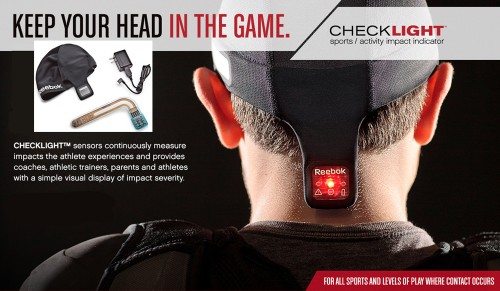I’ve heard a lot of reports about the dangers of brain concussion in athletes in the last year or so. All sorts of sports can pose a risk of concussion, even when protective gear is worn. When my daughter was at a Taekwondo tournament, a black belt received a kick to head and fell to the floor in convulsions, despite all the protective gear he was wearing at the time. That injury was horribly evident to everybody watching the sparring match, but sometimes the injuries are more subtle and are cumulative. Concussions can lead to permanent brain injury, so you need a method that monitors blows to the head and can judge when they are significant. The CHECKLIGHT skullcap from Reebok can be worn for any sport with a potential for head injury; it can be worn alone or under a helmet.
In the inset image, you’ll see the sensor that fits into the skullcap. It makes contact with the head and uses accelerometers, gyroscopes, and microprocessors to monitor “direct accelerations that the head, not a helmet or chin strap, experiences.” It counts the total number of impacts recorded, and using a special procedure, you can see a count of the number and severity of impacts. During game time, the CHECKLIGHT monitors impacts and alerts you when you receive an impact above a defined threshold. A yellow light indicates a moderate impact, red indicates a more severe impact, and both signal the athlete should be removed from the game for evaluation. The CHECKLIGHT doesn’t diagnose concussion, but it helps you see when an athlete may have sustained injury.
The CHECKLIGHT can be used by adult males or females and by children age 6 and up. It’s available now at Reebok for $149.98.




Gadgeteer Comment Policy - Please read before commenting
I realize this post is a product announcement, not an endorsement, but…
My concern with this sort of product is that it is still reactive – it’s giving information after the (potential) damage has already been done. So rather than to look for ways to make the game less about impact and more about moving the ball, I worry that the focus will be on these sorts of after-the-fact technologies that don’t really make football any safer.
@Rob: That’s a possibility, but you could also use these technologies to evaluate if something is actually making the game safer, and to figure out what rules/actions would best help. (And of course, it’s not just for football – it’s for anything.)